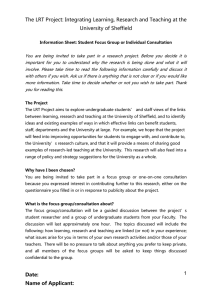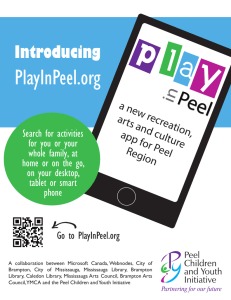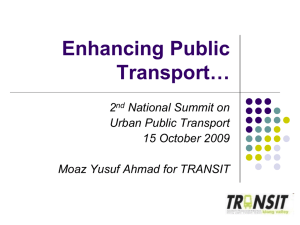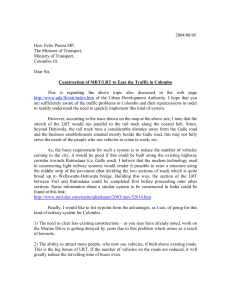Frequently Asked Questions (FAQ) - Mississauga - Brampton
advertisement
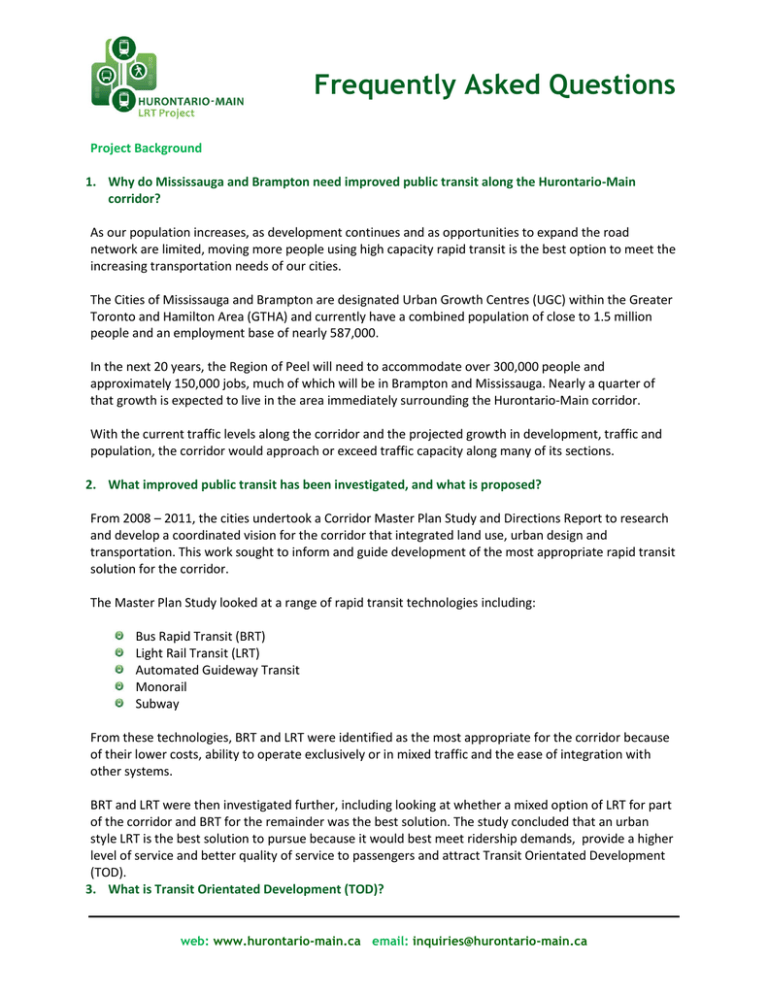
Frequently Asked Questions Project Background 1. Why do Mississauga and Brampton need improved public transit along the Hurontario-Main corridor? As our population increases, as development continues and as opportunities to expand the road network are limited, moving more people using high capacity rapid transit is the best option to meet the increasing transportation needs of our cities. The Cities of Mississauga and Brampton are designated Urban Growth Centres (UGC) within the Greater Toronto and Hamilton Area (GTHA) and currently have a combined population of close to 1.5 million people and an employment base of nearly 587,000. In the next 20 years, the Region of Peel will need to accommodate over 300,000 people and approximately 150,000 jobs, much of which will be in Brampton and Mississauga. Nearly a quarter of that growth is expected to live in the area immediately surrounding the Hurontario-Main corridor. With the current traffic levels along the corridor and the projected growth in development, traffic and population, the corridor would approach or exceed traffic capacity along many of its sections. 2. What improved public transit has been investigated, and what is proposed? From 2008 – 2011, the cities undertook a Corridor Master Plan Study and Directions Report to research and develop a coordinated vision for the corridor that integrated land use, urban design and transportation. This work sought to inform and guide development of the most appropriate rapid transit solution for the corridor. The Master Plan Study looked at a range of rapid transit technologies including: Bus Rapid Transit (BRT) Light Rail Transit (LRT) Automated Guideway Transit Monorail Subway From these technologies, BRT and LRT were identified as the most appropriate for the corridor because of their lower costs, ability to operate exclusively or in mixed traffic and the ease of integration with other systems. BRT and LRT were then investigated further, including looking at whether a mixed option of LRT for part of the corridor and BRT for the remainder was the best solution. The study concluded that an urban style LRT is the best solution to pursue because it would best meet ridership demands, provide a higher level of service and better quality of service to passengers and attract Transit Orientated Development (TOD). 3. What is Transit Orientated Development (TOD)? web: www.hurontario-main.ca email: inquiries@hurontario-main.ca Transit Orientated Development (TOD) is development located within walking distance of transit stations, integrated with transit use, and is generally characterized by: Compact development that is relatively dense compared to its surroundings; A mix of uses including, where possible, transit origins (housing) and transit destinations (employment, institutions, or retail), with pedestrian-supportive uses at street level; A safe, attractive and interconnected public realm, featuring ‘complete streets’ that invite pedestrian and bicycle access; and An approach to parking that includes less supply than in non-transit locations, a pedestriansupportive design, and shared use of facilities. TOD is one of the most effective planning strategies to support an improved quality of life and sustainability of a city. 4. What is ‘urban style’ Light Rail Transit (LRT)? Urban style Light Rail Transit (LRT) is designed to be fully integrated with the surrounding streetscape. At the heart of this approach is a modern styled, low-floor, light rail vehicle (LRV). Low-floor LRVs allow for stops and stations that require very little additional infrastructure. For instance, a stop can be created using only a raised curb and sidewalk. The low floor of the vehicles means that doors are aligned at street-level to allow for step-free boarding so passengers can access directly from the low LRT platform into the vehicle. Because steps are not needed, it is easier to integrate stops and stations with local surroundings, as well as provide better pedestrian connections and fewer barriers to accessibility. Urban style LRT generally runs in its own dedicated lanes to ensure it is not held up by other traffic and it is given priority to go through signalized intersections. This provides a very reliable service with passengers knowing exactly how long their journey will take. The dedicated LRT lanes can be separated from other traffic lanes by a white line or a curb. In addition, the area between rails on the segregated lanes is filled in, usually with concrete, pressed concrete to resemble cobblestones, or other material such as grass. This provides a level surface and enables the LRT to be blended into the surrounding street. 5. What are the benefits of LRT? LRT vehicles have higher capacity than bus transit systems, and provide fast, reliable, convenient service by carrying passengers primarily in reserved transit lanes separate from regular traffic. LRT is electrically powered, with no emissions at street level, and offers passengers a smooth, comfortable and quiet ride. LRT in other cities have also spurred significant Transit Orientated Development (TOD), which is less reliant on the private car and has helped improve connectivity and long-term community sustainability. LRT along the Hurontario-Main corridor seeks to: Provide a high capacity, high quality, reliable, modern transportation system to connect the cities of Brampton and Mississauga; Connect with regional rail services (e.g. Go Transit) at Port Credit and Cooksville in Mississauga and in downtown Brampton; Be integrated into the local transit network (MiWay, Züm and other transit services); web: www.hurontario-main.ca email: inquiries@hurontario-main.ca Help accommodate current and future travel demand; Help to stimulate enhanced streetscapes and transit oriented development along the corridor; Reduce reliance on the private car by offering a viable, attractive alternative; Help our cities grow and develop in a more sustainable way; Transition the cities from ‘suburban’ to ‘urban’; and Improve transit travel time along the corridor. Light Rail Transit In Our Community 6. What is the difference between LRT and streetcars? The main difference between LRT and streetcars is that LRT vehicles run in their own segregated lanes for the majority, if not all, of their route. They also have priority through signalized intersections. In combination these two components ensure that LRT provides a reliable service with journey time certainty. Because Light Rail Vehicles (LRVs) are in their own lane when they stop to pick up passengers, they do not delay other road traffic in the way that streetcars do. LRTs also have dedicated stops with platforms whereas streetcars often stop in the street with passengers then walking into the road in order to board. Finally, LRVs are generally longer than streetcars and so can often carry more passengers. 7. What is a Light Rail Vehicle (LRV)? A Light Rail Vehicle (LRV) is an electrically operated transit vehicle that carries passengers as part of a Light Rail Transit (LRT) system. The specific LRV for the Hurontario-Main system has not yet been selected and will be tendered as part of a future Vehicle Procurement Strategy for the project. LRVs can operate as a single unit, or can be joined to operate as multiple passenger LRV units. 8. Can a LRT system operate in cold weather? Yes. Systems around the world operate in many different weather conditions, including extreme cold in places such as Sweden, Norway, Poland, Germany and in North America including Edmonton, Calgary and Minneapolis. 9. Will LRVs be noisy? Light Rail Vehicles create less noise than two medium sized trucks. Existing and future noise and vibration levels from the LRT system will be examined as part of the current study. The work will be included in the Environmental Project Report (EPR) which is currently being produced and will be available for the third set of Public Information Centres in the Fall. 10. How fast will LRV travel? Light Rail Vehicles (LRVs) are capable of reaching speeds of approximately 80 km/h. However, we would expect the LRV in this corridor to be governed by similar speed limits as other motor vehicle traffic. web: www.hurontario-main.ca email: inquiries@hurontario-main.ca 11. Will the Hurontario-Main LRT line be accessible for persons with disabilities? The best proven accessibility systems and technologies will be applied throughout the Hurontario-Main LRT system. The system will be designed to ensure that passengers with restricted mobility will be able to move safely and comfortably through the system from vehicles to stops with ease. Future Funding and Construction 12. What is the status of securing funding for the project? The Cities and the Project team have met with Metrolinx and discussions about funding for the project are underway. Metrolinx has active representation in the project working groups and provides ongoing support. Funding for the LRT will be explored through Provincial and Federal opportunities as well as through Metrolinx, as they develop an investment strategy for supporting transportation infrastructure improvements within the Greater Toronto Area and Hamilton that is expected to be released this summer. 13. Does Metrolinx support the Project? Yes. Metrolinx identified the Hurontario-Main LRT as a priority project in The Big Move, its Regional Transportation Plan and their support for the project was recently reaffirmed in their “Next Wave” announcement. The Metrolinx Benefits Case Analysis indicated that this project will generate positive net benefits for the region. Metrolinx is excited to see the next stage of work being completed for this project and will continue to work in collaboration with the Cities of Mississauga and Brampton on the planning, design and engineering work underway. 14. When will the LRT be built? It is too early to put a firm time frame on the LRT project implementation, including operations and maintenance. The first step was the Master Plan Study that resulted in the LRT corridor concept. The LRT has now evolved from a concept into a project as we move through the Preliminary Design/TPAP Phase, which will take approximately three years to complete (2011 – 2014). Assuming prompt and favorable funding decisions, the implementation stage could potentially begin in 2014, although it is likely to be later than this before the first construction activity is seen. 15. What will it cost to ride the LRT? Fares collection options are being examined as part of the project, and further information will be available once the analysis is completed. Fare levels have not yet been determined but in line with the objective of meeting the people moving needs of the corridor are expected to be consistent with fares charged elsewhere on the Mississauga and Brampton transit systems. LRT System Design web: www.hurontario-main.ca email: inquiries@hurontario-main.ca 16. What progress has been made on determining the alignment since PIC#1? At PIC #1 the project team consulted with the public on key design elements of the LRT project. Since then the project team has been refining the design using the public feedback which was received. With much of the alignment details having been determined since PIC #1, the Hurontario-Main LRT project team is continuing to work through key design challenges and opportunities in both downtown Brampton and Mississauga to ensure that the final alignment effectively connects the immediate surrounding businesses and residents as well as the region as a whole. 17. How will traffic along Hurontario and Main Streets be impacted by the implementation of the LRT? The Hurontario-Main LRT will provide a substantial increase in people carrying capacity down the corridor through significant increases in transit ridership. Flexible parallel routes and a finer grid of streets in intensification areas will distribute traffic more effectively, with a focus on ensuring that access is maintained via auto, rather than adding more through capacity. The impacts of the project on traffic movements are being fully assessed using industry standard models. The results of this are then being used to minimize impacts on traffic and local access where possible. 18. Will properties be impacted along the corridor as a result of the implementation of the HurontarioMain LRT? Designing a rapid transit system that will span two cities and effectively serve the distinctive needs of both is a massive undertaking. Acquisition of some properties and temporary access to others will be required to implement the system. This will result in frontage impacts, as well as modified access for some properties. The Hurontario-Main project team has years of experience in these critical areas of design and will be applying that expertise to the design of the system to minimize property impacts. A preliminary analysis of affected land has been completed and the team is reviewing potential property impacts. The full extent of property requirements will be determined as part of the Detail Design process. 19. What is the Project team doing to ensure that the character areas in both Brampton and Mississauga are preserved? Preserving the character and beauty of the heritage areas in Brampton and Mississauga, while supporting its modernization and growth for the future, is a key priority of the Hurontario-Main LRT Project. This priority will remain top-of-mind for the Cities and the LRT project team as they progress through the design and alignment challenges and opportunities. Public feedback is critical to support and inform these decisions and is encouraged as we enter into the final stages of the design process. 20. How will the LRT be integrated with events in Brampton and Mississauga? web: www.hurontario-main.ca email: inquiries@hurontario-main.ca The Hurontario-Main LRT project team understands the importance of cultural and community events in Brampton and Mississauga and are applying event considerations into the LRT design that will complement these priorities. The project team is committed to working through these challenges and opportunities with local stakeholders and event coordinators. 21. How is cycling being incorporated along the alignment? The Hurontario-Main Street corridor is being designed to accommodate bicycle lanes and bike paths from Mississauga to Brampton. The project team is working to apply designated bike lanes wherever feasible along the corridor. A variety of bike lane typologies are being deployed, (on-street; raised curb; or multi use trail) to suit the variety of settings along the corridor. In all cases, the priority is to design the facility to maximize the safety and comfort of cyclists and other users of the roadway. 22. How is the urban realm being incorporated into the LRT design and along the corridor? Stops, streetscapes and other components of the public realm along the corridor will be designed to support a safe, attractive and comfortable environment. Applying their experience and expertise, the Project design team is making every effort to design a beautiful, accessible streetscape for the corridor, providing space and amenities to encourage walking, cycling and transit. Some design opportunities will come forward as part of this project, while others will emerge through change and development on lands beside or near the corridor, undertaken by individual property owners and other stakeholders. 23. Have the location of the LRT stops been chosen and if so how were they chosen? The location of the LRT stops must effectively serve those along the Hurontario-Main corridor and ensure smooth, easy transfers to key destinations between other transit connections and were selected based on this premise. The preliminary preferred locations of the LRT stops along the alignment have been selected with this understanding in mind as well as incorporating feedback from PIC #1. 24. How is the project team incorporating the Hurontario-Main LRT system with other regional transit networks? The Hurontario-Main LRT project will be complimented by a number of upcoming transit projects with the goal of improving connectivity in the GTHA that will allow for improved travel times to and from Mississauga and Brampton as well as to other major transit hubs in the Greater Toronto Area. Changes in bus services through the corridor will allow for local routes in Brampton and Mississauga to better accommodate growing demand and ridership as public transit options expand and greater transit connections for commuters become available. web: www.hurontario-main.ca email: inquiries@hurontario-main.ca 25. What are intermodal stops and how will they be integrated with other transit services? The anticipated growth of Brampton and Mississauga will require effective regional connectivity of local transit systems to surrounding mobility hubs to integrate with other transit services. Linking the LRT with regional transit systems and GO Transit will enable the future growth and development along the Hurontario-Main corridor and secure Brampton and Mississauga’s place as two world-class cities. 26. Will the LRT include parking at intermodal stops? As part of the current study we will be looking to ensure there is good connectivity to the local transit network and the wider regional bus and GO train services. That said, improvements such as parking provision at GO Stations or mobility hubs are outside of the scope of this project. To provide Metrolinx with your GO Station comments, please call their Customer Service staff 416.874.5900. 27. What hours will the LRT operate? The system is anticipated to run from 5am to 1:30 a.m. Monday to Saturday and from 7am to midnight on Sundays. The exact times of operation for the Hurontario-Main LRT will be determined as the project develops. At this stage we will be looking at potential operating scenarios and determining those that best meet demand. 28. What are sub-stations and how do they fit into the streetscape? Traction power sub-stations take electrical power and convert it to the necessary voltage to power the light rail vehicles. Typically they are located about every 1.5 km along the route and would be housed in small buildings which have been designed to be as unobtrusive as possible and fit into the general streetscape. The Hurontario-Main LRT project team is working to determine the type of power that will be used to power the system which will also determine the number of TPSS that will be located along the alignment as well as their specific locations. The preliminary preferred locations of the LRT stops along the alignment have been selected with this understanding in mind as well as incorporating feedback from PIC #1. Some property may be required for some of the proposed TPSS locations. However, the location of the property and the amount of space needed is still under review and will be determined by PIC #3. 29. Where will the Maintenance and Storage Facility be located and why was that location chosen? The Maintenance and Storage Facility (MSF) will be located south of the 407 on lands bounded by the 407, Kennedy, Hurontario and the Hydro corridor. web: www.hurontario-main.ca email: inquiries@hurontario-main.ca The location of the Maintenance and Storage Facility (MSF) has been chosen based on an optimal location that will provide a safe and secure operational area for vehicles to be stored and serviced as well as ensuring the safety of drivers, facility staff, visitors, neighbours and the public. Route Alignment 30. Where is the Hurontario-Main LRT ‘route alignment’ located? The proposed route alignment (from south to north) begins in Port Credit near Stavebank Road, proceeds east on Port Street, north on St. Lawrence Drive onto Hurontario Street until you arrive at Burnhamthorpe. At Burnhamthorpe, a loop runs around the Mississauga downtown which goes along Duke of York, to Rathburn and Hurontario. From the north side of this loop, you continue on Hurontario Street to Main Street until you reach Brampton’s GO Station. 31. What is the preferred option for the Mississauga Downtown alignment and how was it determined? The LRT alignment presented at PIC #1 in June 2012, reflected the alignment in the Downtown21 Master Plan which was comprised of Burnhamthorpe Road, Living Arts Drive, Rathburn Road, City Centre Drive and a new bridge crossing Highway 403. The public was informed at PIC #1 that further assessment in determining the downtown alignment that is both feasible and supports the future vision of Downtown Mississauga, was underway and would be evaluated extensively. Different alignment options on the east, west and north of the downtown area were developed and assessed using a large number of considerations, including engineering feasibility, city-building potential, stakeholder impact and ability to assist in achieving the DT21 Master Plan Guiding Principles. Following this evaluation, the preferred option for the downtown LRT is Burnhamthorpe Road, Duke of York Boulevard, Rathburn Road and Hurontario Street. The Highway 403 crossing has not yet been decided. 32. What options are being presented for the Brampton Downtown alignment and how were they determined? Since PIC 1 in June 2012, the Hurontario-Main LRT project team and the City of Brampton, have been evaluating two options for the alignment through the downtown, between Queen and Nelson Streets. Evaluation methods such as engineering feasibility, city-building potential, stakeholder impact and feedback were applied to help to review both the Transit Mall Option and the Four Lane Option as the preferred LRT alignment in downtown Brampton. The Transit Mall Option best supports Brampton’s Vision for the downtown area to develop into a vibrant, pedestrian oriented space between Queen Street and Nelson Street. By redirecting vehicle traffic to alternate routes with the prevention of through traffic, the Transit Mall Option will establish a more generous pedestrian focused public realm and better preserve the calm and scenic character of the Heritage District as part of one of the key project objectives. web: www.hurontario-main.ca email: inquiries@hurontario-main.ca The four Lane Option of providing one through traffic lane north and southbound on Main Street was also reviewed as an option for the downtown alignment. This option would provide limited vehicle movement north and southbound on Main Street for motorists and maintains existing sidewalk width as is present today. Although this option does preserve limited through traffic on Main Street for motorists, it also will remove on-street parking on Main Street. 33. What does ‘segregation’ or ‘segregated lanes’ mean? Segregation or segregated lanes means the LRT would operate in outs own dedicated rail transit lanes along the alignment and so will not be held up by other vehicles. This will help to ensure journey time reliability and consistency. 34. Why did Brampton invest in Züm if the City was planning to implement LRT? The Züm Bus Rapid Transit (BRT) system was designed to accommodate future capacity and growth. LRT is being planned to accommodate long-term growth in transit ridership. Without LRT, buses will run at more frequent intervals resulting in increased congestion and reduced transit service levels. The Züm infrastructure, such as the station stops, can also be moved to future BRT lines in Brampton. Züm buses can also be redeployed to other existing or future BRT routes. 35. Will Züm buses continue operating on Hurontario? Yes, for the time being. Once the LRT is operational, Züm service will be re-routed to other new corridors where Züm services are not currently operating. Local bus service between LRT stops is expected to remain in operation. 36. Why is LRT only going to Downtown Brampton and not Sandalwood? The scope of this phase of the project focuses on the corridor from Port Credit in Mississauga north on Hurontario through Main Street to downtown Brampton. However, future expansion of the LRT is not precluded, including a northerly extension and potential connection with Queen Street rapid transit services. Public Consultations 37. How can I participate in design consultations? The second of three Public Information Centres (PICs) in Mississauga and Brampton, PICs help to inform the public of updates to the design progress, and seek feedback during the different phases of the project. Project team members from the cities and the consultant team will be in attendance to discuss the project and answer your questions. The first PIC featured material and saught feedback on the LRT route alignment, segregated lane options and LRT stop locations. This second PIC will seek feedback on the preferred alignment and the third PIC anticipated for fall 2013, will form part of the TPAP environmental assessment process. PIC dates and locations will be advertised in advance, and information will also be mail dropped along the corridor. Consultation materials will be posted on the project website at www.hurontario-main.ca. web: www.hurontario-main.ca email: inquiries@hurontario-main.ca You can also tell us what you think through the consultation portal on the project website, or by emailing comments to inquiries@hurontario-main.ca. 38. Will my opinion make any difference in the outcome? Yes. Our team is here to listen, to understand and to consider public and stakeholder opinions to help inform development of the preferred alignment and the design. Our team needs your help to guide decisions at key points in the project. 39. Will non-transit users have a say? Yes. The views of many stakeholder groups will be sought and used to inform development of the LRT, including motorists, businesses and residents, developers, First Nations, cyclists, seniors, and others directly and indirectly affected by the LRT. 40. May I speak with the Project Team? Yes. The designated contacts for this phase of the project are: City of Mississauga Matthew Williams, Project Leader 905.615.3200 ext. 5834 matthew.williams@mississauga.ca City of Brampton Consultant Team Khurram Tunio, Senior Project Engineer 905.874.2500 Khurram.tunio@brampton.ca Hurontario-Main LRT Project Team Lindsey Bethke, Communications Advisor 416.252.5311 ext. 3806 lindsey.bethke@snclavalin.com web: www.hurontario-main.ca email: inquiries@hurontario-main.ca
